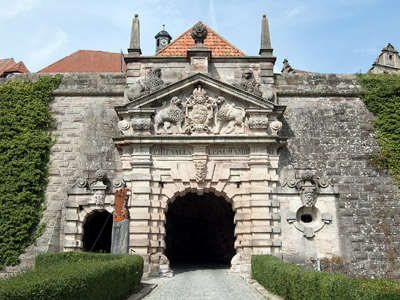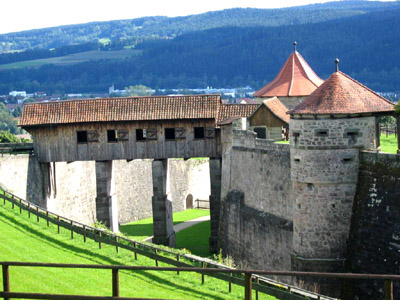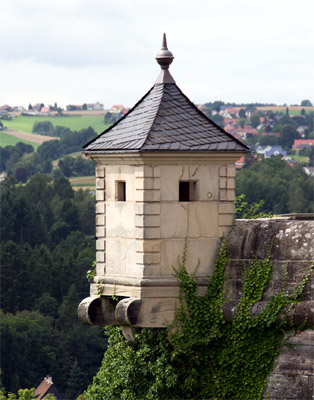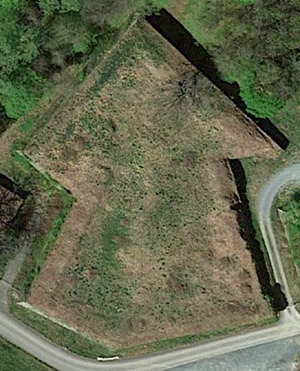 |
Festung Rosenberg
Kronach, Bavaria, Germany
|
|
 |
Completed: 1662
Used by: Bamberg Prince Bishops, Germany
Conflicts in which it participated:
Thirty Years' War,
Seven Years' War
|
Let's all take a moment to appreciate rivers. Where navigable rivers flowed into other navigable rivers, particularly in the cramped, historically volatile region known as Europe, the persons in charge of the area often wished to command those confluences. Hill forts, ring forts, castles and then starforts filled this role. Were it not for rivers, there would have been little reason for there to be any inland starforts, which we so appreciate today.
The rivers which in this case it is our imperative to appreciate are the Rodach, Haßlach and Kronach. They meet at the wee Bavarian burg of Kronach, which was in need of a starfort, in that it was, for reasons we will learn shortly, at Germany's fractious border betwixt Catholicism and Protestantism. |
 |
 |
|
There was of course no such religious border in the 8th or 9th century when Kronach was first established: Christianity was Catholicism, and Catholicism was what you followed if you did not wish to be impaled. Holy Roman Emperor Heinrich V (1081 or 1086-1125) gave Kronach and its surrounding area to the Bishopric of Bamberg in 1122, at a time when Bamberg, a city about 30 miles to Kronach's southwest, was considered the "center" of the Holy Roman Empire. The mighty Prince Bishop Sultans who ruled Kronach needed a plushy and secure pad in which to kick back, and for this reason the fortified kernel that would eventually bloom into Festung Rosenberg was initiated in the mid-13th century: Kernberg.
|
 The three rivers that made Kronach important. Click on it, it makes a lot more sense when it's bigger and you can actually see it. The three rivers that made Kronach important. Click on it, it makes a lot more sense when it's bigger and you can actually see it. |
But things were not all fröliche bier und wurst in the Holy Roman Empire. The Peace of Augsburg (1555) declared that German states could officially choose betwixt Catholicism or Lutheranism, as devotees of those two branches of Christianity were having such a difficult time coexisting. While doubtless ending some immediate friction, this separation defined distinct borders within the Holy Roman Empire, leaving Bavaria a mighty bastion of Catholicism, while the German states to its immediate north were rife with pesky Lutheran Protestants.
In addition to its location near that border and being the place where the three aforementioned rivers met, Kronach was also the meeting place of three major trade routes: All roads, rivers and Prince Bishop Potentates led to Kronach. |
|
|
|
What's a Germanic Prince Bishop to do in such a situation? Bestärken. Kernberg was the name of the initial hilltop castle that was built to protect all of these things in need of protecting, whose construction got underway in the 13th century. Today's lovely starfort still utilizes some of this original work's foundations, and the keep, minus its semi-modern roof, dates to this fort's inception.
The only entrance to Kerberg was the Hospital Gate, which was protected by the expected drawbridge and stout oak gate, but also sported a Wolfsgrube, or Wolf's Pit. This was the medieval equivalent of the punji pit, which French and American troops would so enjoy whilst fighting in Southeast Asia in the 20th century. Kernberg also boasted a 150-foot-deep well, which was fed by several natural springs. In its earliest form, Kernberg was primarily the fotified home of the Prince Bishop. Additions were made in the 15th century, encircling the original castle with an outer ring of further defense.
|
Every website at which I've gleaned information about the Festung of our present attention proudly says something akin to, "Festung Rosenberg was never taken by violent action!" Kerberg, however, did spend some time in the hands of the unwashed during the Peasant's War (1525-1526). The town and castle were surrendered to the peasants without a fight, so there was no "violence" in the castle-capturin' process.
Similarly, the Napoleonic French would later benefit from the Festung's perfect record by being granted possession of the fort without contention. It's a foolproof scheme for maintaining your starfort's vicious reputation: Undefeated in war! Because it was surrendered at virtually every opportunity!
|
 |
 All of Festung Rosenberg's noteworthy features, which I've translated for those of us who speak English (which I'm guessing is pretty much all of us), so if there's something that doesn't make any sense or is flat wrong, that would be me. All of Festung Rosenberg's noteworthy features, which I've translated for those of us who speak English (which I'm guessing is pretty much all of us), so if there's something that doesn't make any sense or is flat wrong, that would be me. |
|
Which of course wasn't actually the case. Kernberg passed up a prime opportunity to surrender in October of 1553, during the Second Margrave War (1552-1555). Troops led by Albrecht II Alcibiades (1522-1557), bent on fighting both Catholicism and the thought that Albrecht might not be the coolest and most powerful prince of 'em all, marched before Kronach and demanded Kernberg's surrender. Town and castle refused, but the troops Albrecht had at his current disposal were insufficient in number to enact a siege. With no other choice but to skulk away, Albrecht went and captured the much richer prize of Bamberg, which was not fortified.
|

If your starfort's gonna have a gate, why not make it a gate! The puritan sensibilities that went into the design of the starforts of the United States may have been admirable on some levels, but they certainly never produced a gate as sumptously lavish as Festung Rosenberg's. |
 |
Bamberg may or may not have learned its lesson from this experience, but Kronach noted that a fortification had saved Kronach, while no fortification had demonstrably not saved Bamberg. Work was soon underway on a third ring of fortifications around Kernberg, in form of four wood and earthen bastions which were complete by the beginning of the 17th century. There are no remnants of this defensive ring left today. Would those bastions have been recognizable today as starfort bastions? This seems likely, as a craze for starfortery had swept through Europe in the 16th century.
The living quarters for the nobility in Kernberg were also improved during this period, with the aim of making it a comfortable (and secure) home for the bigshots of Bamberg. |
|
|
It was with these four bastions (and comfy living quarters) that (what was by this point certainly being referred to as) Festung Rosenberg withstood its greatest trial. The Thirty Years' War (1618-1648) brought the dastardly Swedes and their German allies to Kronach on more than one occasion, and the town and festung were beseiged on and off from 1632 to 1634.
In an era when grouping a bunch of guys (say, a besieging army) together for any length of time automatically meant dysentery and/or disease, a siege was generally pretty hard on both sides. During one of these sieges, the Kronachers used a creative bit of psychological warfare: Though the town was starving, the last edible animal within reach of the townsfolk, a female rabbit, was encouraged to scamper about in plain view of the Swedes. From this the besiegers surmised that Kronach still had plenty of food, and would be able to hold out indefinitely, or at least longer than the Swedes could. The siege was lifted and the town was saved.
|
From this event, the townsfolk gained the nickname of "Kronacher Rabbit Cows," which translation probably doesn't do the term any favors: Kroniche Housnküh sounds way cooler. The bunnyrabbit has been the town's mascot ever since this heroic event.
In remembrance of Kronach's doughty defense against the Swedes, since 1633 there has been an annual "Swedish Procession" through the streets of the town, with women proceeding before the men, in recognition of their particular bravery during the sieges. And maybe those women were brave, but Kronachers weren't given the nickname of "Kronacher Women Cows." Well, maybe some of them were.
|
 |
 There are lots of starforts, and lots of pictures of starforts. Very few of these pictures feature starforts blanketed in lovely snow. Thank you, weather. There are lots of starforts, and lots of pictures of starforts. Very few of these pictures feature starforts blanketed in lovely snow. Thank you, weather. |
|
While they proved enough to defy the Swedes in the 1630's, our festung's earth 'n timber bastions were really just a temporary measure, and construction of a masonry alternative got underway in the second half of the 17th century. A starfort in a Catholic situation wouldn't be a real starfort until it had named all of its bastions after saints, and Festung Rosenberg was no exception. Its five masonry bastions were named thus:
- St. Kunigunde: Kunigunde of Luxembourg married Bavarian King Heinrich IV in the 10th century, and as far as I can tell was canonized because a) she once walked over hot coals to prove she was a virgin, coming away unscathed (but pregnant!), and b) because her husband (who was the king) wished for her to be canonized. Kunigunde was later credited for saving Kronach from Allied bombers during the Second World War (1939-1945) by hiding the town with a veil of smoke.
- St. Valentin: Named for one of the Prince-Bishops of Kronach.
- St. Lothar: Named for another of the Prince-Bishops of Kronach.
- St. Philip: Wouldn't you know it, it's a Prince-Bishop of Kronach.
- St. Heinrich: As the husband of St. Kunigunde, Bavarian King Heinrich IV was a guy with the pull to get things done: Like get his wife canonized, over 100 years after her (and his) death!
|
|
 The only manner by which one might access Festung Rosenberg's outer ring of luscious starfortery, absent a helicopter or a really tall ladder, is via one of two unlikely-looking covered bridges. The only manner by which one might access Festung Rosenberg's outer ring of luscious starfortery, absent a helicopter or a really tall ladder, is via one of two unlikely-looking covered bridges. |
 |
As formidable as Festung Rosenberg was after the addition of its five saintly bastions, the Prince Bishops residing therein stroked their collective chins and muttered, "It must be...formidibler." Any attack on the festung would surely swoop down from the north, which was the fort's landward side. Accordingly, another heapin' helpin' of starfort goodness was added in the mid-18th century, strengthening the festung's northern defenses.
These four works were initially named with numbers (VI though IX), but two eventually took on names of even more Prince-Bishops: Contregarde Carl (VI) and Ravelin Anton (VII). They finally ran out of Prince-Bishops for VIII and IX, however. Or maybe by this point the Prince-Bishops were named with Roman numerals? |
|
|
And these new defensive works came in handy almost immediately, as the Seven Years' War (1756-1763) brought Prussians, led by Major General Karl Gottfried von Knobloch (1697-1764), to Kronach in May of 1759. The Prussians set up artillery on a hill to the east of town and opened fire, but their guns were too puny to reach Festung Rosenberg. Our festung's guns, on the other hand, had plenty of range to make the Prussian hilltop an unhealthy place to be, so Knobloch and his "Fightin' Knobbers" (I made that up) departed, adding yet another notch to the (semi-)unassailable Festung Rosenberg's pistol grip.
|
Our festung's next series of "improvements" came about thanks to the guy who we all love to hate: Napoleon Bonaparte (1769-1821) (unless we're French, in which case we probably actually love him). The Holy Roman Empire took a faceplant in 1806, leaving Bavaria more or less at loose ends. Bavaria thought the whole Napoleonic thing was swell, modernizing and in many ways modeling itself after France. Fancying himself an expert on such matters as fortification (which he kinda was), Napoleon took an interest in Festung Rosenberg, which came to his attention during his campaign against Prussia. He directed that fourteen guérites, which had been decorating the leading edges of every pointy tip the festung had to offer, be removed. The Tiny Tyrant intended for Festung Rosenberg to help cover his retreat, should things not turn out as planned with the Prussians, and his assertion was that guérites would just serve as aiming points for enemy gunners, which was exactly what I thought about the things when I first learned of them! Yes sir, lots in common, me 'n' Nappy B. In early 1812, Kronach was used as a staging area for French, Italian and Bavarian troops who were lucky enough to participate in Napoleon's Russian campaign.
|
 |
 Fortunately for guérite fans, some of Festung Rosenberg's wachhäuschen were rebuilt in the 20th century. This one's on the salient point of the St. Kunigunde Bastion. Fortunately for guérite fans, some of Festung Rosenberg's wachhäuschen were rebuilt in the 20th century. This one's on the salient point of the St. Kunigunde Bastion. |
|
Anyone with a glancing interest in military history knows that this campaign did not turn out well for the French and their allies, and when the small, tattered percentage of troops who survived the retreat passed through Kronach on their way home in 1813, they did so with Festung Rosenberg, bravely guériteless (also with a new pair of French 18-pounder guns installed atop the keep), watching over them protectively. Had they just taken Festung Rosenberg with them on this campaign, it would probably be installed in Moscow to this day, dispensing French justice and enlightenment.
|
 Festung Rosenberg's Ravelin Anton features a design that one would think should be common to starforts, what with the angular pointiness that is universally manifest...the arrow. Yet, this is almost unique to the festung of our present interest. Festung Rosenberg's Ravelin Anton features a design that one would think should be common to starforts, what with the angular pointiness that is universally manifest...the arrow. Yet, this is almost unique to the festung of our present interest. |
 |
Our festung was thereafter proactively manned and readied for action on several occasions until 1867, when the Bavarian War Ministry officially "abolished the fortress property" of Festung Rosenberg. It was immediately pressed into service as a military prison, and then in 1869, a civilian prison. The serving prisoners who had been convicted of the dastardly crime of Majestätsbeleidigung, which as we all know is intentional insult or violence against a monarch, were pardoned at the outset of the Franco-Prussian War (1871) in order to make room for the expected influx of French POWs.
Prison Festung Rosenberg was closed in 1875, and the town of Kronach saved it from demolition in 1888 by scraping together 32,000 marks. Which proved to be a wise move, as the festung was once again tidied up for POWs during the First World War (1914-1918). Around 500 French, Russian, English and Belgian officers and men were imprisoned therein over the course of the conflict.
Upon solemnly vowing not to attempt to escape, imprisoned officers were permitted free access to the town, plus discounts on meals. One officer who refused to give his word of hono(u)r not to escape was that most heroic of Frenchman, namely Charles de Gaulle (1890-1970). |
|
|
De Gaulle spent a total of 32 months imprisoned in six different German POW camps during the war, and by all accounts was a busybody escape-attempter at them all. Festung Rosenberg was Charles' first POW experience, whence he tried to escape twice, somehow endeavoring to make it over the festung's frightfully high walls. For this he was punished with 60 days of "intensified arrest," which probably means solitary confinement. Life in the festung couldn't have been all that bad, because after the war a number of civilians lived therein, assumedly of their own volition.
|
 Specific information regarding the dates on which Festung Rosenberg's noteworthy construction events took place are pretty scarce online, so I was excited to come across this shot, of a helpful sign right outside the festung's main gate. However, it's juuuust too small to make out what the sign is saying! Thanks for posting it, Herr Whomseover, but for goodness' sake. Specific information regarding the dates on which Festung Rosenberg's noteworthy construction events took place are pretty scarce online, so I was excited to come across this shot, of a helpful sign right outside the festung's main gate. However, it's juuuust too small to make out what the sign is saying! Thanks for posting it, Herr Whomseover, but for goodness' sake. |
 |
More prisoners got to hang out in Festung Rosenberg during the Second World War (1939-1945), only this time the lucky winners were Polish and Soviet forced labor units, who were being utilized to manufacture porcelain for the war effort...because if you ask any belligerent nation, the one thing they'll tell you they can't get enough of is porcelain.Towards the end of the war a plan was hatched to reconfigure some of the festung's outer works for the secret production of parts for the Messerschmitt Me-163 Komet, an adorable little rocket-powered interceptor that was never produced in enough numbers to affect the war's outcome. Production of this planelet never got started at the festung, which likely spared our starfort from being bombed into oblivion by allied aircraft! Gotcha, 'twas actually St. Kunigunde's magical veil of smoke that saved Kronach from such a fate, as we established several paragraphs ago. |
|
|
Today, the town of Kronach and state of Bavaria annually pour a great number of Euros into Festung Rosenberg's maintenence and development. It houses a dizzying array of museums, event halls, a restaurant, a cafeteria, and lots and lots of etcetera. Guided tours are offered daily, except for Monday, which doesn't count as an actual day, now does it.
|
|
|
|
|
|
 |




